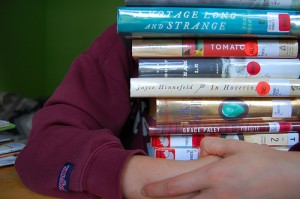Reading the gender binary
April 21st, 2011 | Filed under: teachingI’ve been thinking a lot about the idea of teaching to boys and teaching to girls. I even had my mom bring over my battered copy of Reading Don’t Fix No Chevys from the states. My worry is that through these ideas – of accentuating the gender binary in our pedagogical strategies – that we might be enforcing this binary and pushing kids that don’t fit into it further into the fringe. Photo by sleepyneko.
I’m not the most well-read when it comes to YA lit, which is one of the many reasons I adore and appreciate and never take for granted the wonders of librarians. I depend on them and seek them out when I need recommendations or ideas of how to engage a student. Maybe the librarian even knows this student and can give me some ideas about what he might like. I get that it is much easier to describe texts with terms like “boy-friendly” or “girl-friendly.” It’s important to get boys reading. I will never dispute that. But I wonder if it’s more important for us to frame this as getting children reading and abandon this binary.
Thanks to amazing programs and a society with more and more progressive leaders, children are feeling more empowered to come out as whoever they might be. Young girls are coming out as lesbians at an earlier age. Boys are coming out as gay. Children are self-identifying as genders other than the ones they were assigned at birth. And then there are those “tom-boys” and “sensitive guys” that don’t fit the ideas of what publishers deem “boy-friendly.” What about all of these kids?
As a woman I know I’m often offended at the assumption I love rom-coms and tear-jerker films…or that I love jokes about high heels and how “men just don’t get it.” I don’t, for the record. I like documentaries and funny movies and sci-fi. I like comic books. I love RPG video games, but don’t like first-person shooters and things like Call of Duty. I love computers and technology and reading about science. But then again I also love cooking and read food blogs. I love knitting and arts and crafts. I enjoy surrounding myself with artists and designers. I despise clothing and shoe shopping, but like going to the hardware store and DIY projects. I liked R.L. Stine books as a child, but could never get into The Babysitter’s Club, though I had been known to read a few Sweet Valley High books. So…what book might a publishing company recommend for me?
People are complex and children are even more complex as they explore their identities and try to pinpoint who they are and who they want to become. Labels are helpful and make parts of our jobs easier, but they can dehumanize and mask the personality nuances that could allow us to see the real child hiding underneath. The girl that loves to knit but watches sci-fi and likes weilding a handsaw. Or the boy that loves to read fashion magazines, watch Top Model, and is captain of his soccer team.
I attended an ALAN convention once and sought out an LGBT workshop. This is a passion of mine and has been since I started on this teaching journey. I want every child to feel welcome and comfortable in my classroom – not ashamed or afraid to be who he or she or ze wants to be. It was refreshing to hear that authors were moving from books with the expected LGBT themes of coming out to including characters who are amazing and complex and who just happen to be gay. We as educators also need to look for books like these. Consider titles that include diverse characters – diverse in race, gender, sexuality, religion, etc. I’ve been thinking a great deal about these things as I have been charged with developing language arts curriculum and selecting books for the new international school I’m helping to open this fall. I feel a heavy weight of responsibility as I do this – not something I’m taking lightly – and something I’m seeking the help of others in doing because I know it’s dangerous to have one person make all of these choices. One person with biases, ideas, and perspectives.
So how do we do this? How does our language and how we label text effect the ways in which we help students (all students) learn and experience our classrooms?
Tags: boy-friendly, differentiation, gender, gender-neutral pronouns, girl-friendly, LGBT, reading, Reading Don't Fix No Chevys, text selection, tom boys, YA, YA lit 4 Comments »

